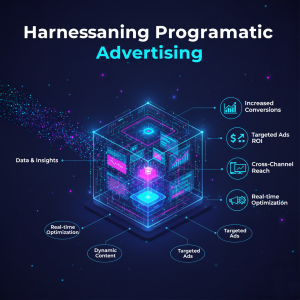How Does Programmatic TV Advertising Work?

The media scenario undergoes a massive change and leads the programmatic TV advertising fee. With its ability to combine traditional TV access with data-driven accuracy of digital marketing, the programmatic TV quickly becomes one of the most powerful tools in an advertiser’s Arsenal.
What Is Programmatic TV Advertising?
In its core, programmatic TV advertising means buying and optimizing a TV advertising portfolio using automated technology and data. Unlike the methods for buying traditional ads, which often involve interactions on deals on the telephone or e-mail, use software to streamline the programmatic advertising process.
Programmatic TV makes it possible to target specific audiences across various platforms, including:
- Traditional linear TV
- Connected TVs (CTV) and streaming services
- Video-on-demand (VOD) platforms
Instead of broadcasting an ad to a common audience, programming TV advertisers allow zero on special demographics or behavior patterns, ensuring the right message when the right audience at the right time.
How Is Programmatic TV Different From Traditional TV Advertising?
The primary difference lies in the data and technology. Traditional TV advertising often relies on broad demographic segments (e.g., “Women aged 25-34”) and manual processes. On the other hand, programmatic TV combines automation and real-time data to deliver highly personalized targeting and reporting.
For example:
- Traditional buying might involve booking a slot in a prime-time show to reach a wide audience.
- Programmatic buying uses data to target households likely to be interested in your product, even if they’re watching less traditional content, like a niche show on a streaming platform.
This data-driven approach enables advertisers to track effectiveness more accurately and make real-time adjustments to campaigns as needed.
How Programmatic TV Advertising Works
To grasp how programmatic TV advertising functions, it’s essential to understand the process from start to finish. Here are the key steps:
1. Audience Identification
Before launching a campaign, advertisers first identify their target audience. This could involve:
- Building personas based on demographic information like age, gender, location, and income.
- Leveraging behavioral data, such as past purchases, browsing history, or content preferences.
- Utilizing customer relationship management (CRM) data or third-party data sets for even deeper insights.
For example, a car company may want to target mid-income households researching new vehicles or families likely to purchase an SUV.
2. Access to TV Inventory
Advertisers gain access to available TV ad inventory through programmatic platforms. These platforms connect buyers (advertisers) with sellers (TV networks, connected TV platforms, and streaming providers), functioning much like a stock exchange for ad slots.
Some popular platforms for accessing programmatic TV inventory include:
- Demand-Side Platforms (DSPs): Where advertisers bid for ad inventory based on their target audience and campaign goals.
- Supply-Side Platforms (SSPs): Used by publishers or broadcasters to sell their ad slots.
- Ad Exchanges: Marketplaces where advertisers and publishers trade ad space in real time.
3. Automated Ad Buying
Once you’ve identified your audience and accessed a platform, the actual buying process begins. This relies on real-time bidding (RTB), where advertisers bid for impressions in milliseconds. Advertisers who bid the highest for a given audience segment win the placement.
For example:
- An advertiser selling fitness gear might bid high for impressions targeting health-conscious individuals watching a fitness show on a streaming platform.
- If their bid wins, their ad will be shown to that audience instantly.
4. Dynamic Ad Delivery
Once the ad is purchased, it’s delivered to the desired audience in real-time. Depending on the platform, this could be on a traditional TV channel, via a connected TV device like Roku or Apple TV, or through an on-demand service like Hulu.
Thanks to advanced data segmentation, these ads are tailored and personalized to ensure maximum relevance and engagement.
5. Performance Tracking & Optimization
One of the most significant benefits of programmatic TV advertising is its ability to measure performance. Advertisers receive detailed analytics on:
- Impressions delivered
- Viewer engagement
- Conversions (if applicable)
With these metrics, campaigns can be continuously optimized for better results, such as reallocating budget to high-performing segments or updating creatives to increase viewer response.
Types of Programmatic TV Advertising
There are a few distinct categories of programmatic TV advertising, and understanding them can help you select the right approach for your campaigns:
1. Programmatic Linear TV
This includes traditional TV content distributed on satellite or cable. Ads buy advertising tracks based on the profiles of the audience, similar to traditional methods, but the process is automated and supported by data.
2. Addressable TV
Addressable TV allows advertisers to target specific households rather than delivering ads to all viewers of a particular channel. For instance, a car manufacturer can target households known to be interested in new cars, even if they’re all watching different shows.
3. Connected TV (CTV)
CTV refers to ads delivered via internet-connected devices like smart TVs or services like Netflix and Amazon Prime. This format allows granular targeting and the ability to reach cord-cutters who no longer use traditional cable.
4. Over-the-Top (OTT) Ads
OTT refers to streaming content delivered directly over the internet. Advertisers use programmatic technology to insert ads into popular streaming platforms, such as YouTube TV, Disney+, or Hulu.
Why Programmatic TV Advertising Is a Game-Changer
There are several reasons why programmatic TV is revolutionizing advertising:
1. Precision Targeting
Programmatic TV uses real-time data to target viewers down to a household level. This means fewer wasted ad dollars and more meaningful engagement with the audience that matters most.
2. Improved ROI
Advertisers can track the performance of their campaigns with detailed analytics. This allows them to adjust their strategy to maximize return on investment.
3. Flexibility
Whether you’re launching a national campaign or a hyper-local initiative, programmatic TV provides unmatched flexibility and scalability.
4. Reach Cord-Cutters
With the rise of streaming services and connected TVs, fewer people watch traditional linear TV than before. Programmatic TV enables brands to reach these viewers across devices and platforms.
Challenges in Programmatic TV Advertising
While the benefits are significant, there are still challenges to consider:
- Fragmentation: With so many platforms and services, managing campaigns across them can be complicated.
- Data Privacy: Viewer targeting relies heavily on data, raising concerns about privacy compliance.
- Cost: While often more efficient, programmatic TV can be more expensive upfront compared to traditional ad buying.
Final Thoughts: Is Programmatic TV the Future of Advertising?
Programmatic TV advertising is transforming how brands hook up with their audiences. By merging the massive attain of television with an appropriate focused on to digital advertising, it gives unprecedented opportunities for advertisers to deliver impactful campaigns.
If you’re looking to unlock the full potential of your TV advertising method, adopting programmatic is no longer a nice-to-have-it—it’s a necessity.
For advertisers geared up to take their campaigns to the next level, programmatic TV provides the tools to accomplish that with unequalled performance and insights. Don’t watch for your competition to get ahead. Explore programmatic TV advertising these days and reap the advantages of this current method.





